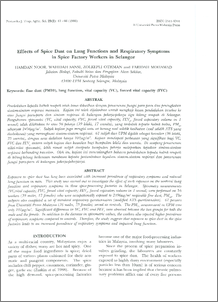Citation
Noor, Hamdan and Sansi, Wahidah and Othman, Zolkepli and Mohamad, Faridah
(2000)
Effects of spice dust on lung functions and respiratory symptoms in spice factory workers in Selangor.
Pertanika Journal of Tropical Agricultural Science, 23 (2).
pp. 61-66.
ISSN 1511-3701
Abstract
Exposure to spice dust has long been associated with increased prevalence of respiratory symptoms and reduced
lung function in man. This study was carried out to investigate the effect of such exposure on the workersi lung
function and respiratory symptoms in three spice-processing factories in Selangor. Spirometry measurements
(VC, vital capacity; FVC, forced vital capacity; FEV1, forced expiratory volume in 1 second) were performed on 56
workers (39 males, 17 females) who were occupationally exposed to 249611g/m3 respirable fine dust, PM10
' The subjects also completed a set of standard respiratory questionnaires (modified ATS questionnaires). 61 persons
from Universiti Putra Malaysia (36 males, 25 females) served as controls. The PMlO measurement in UPM was
only 10111g/m3. Significant differences in VC, FVC and FE~ were observed between the two groups for both the
male and the female. In addition to the decrease in spirometric values, the workers also reported higher prevalence of respiratory symptoms compared to controls. Therefore, the study suggests that exposure to spice dust in the spice factories leads to an increased prevalence of respiratory symptoms and impaired lung function.
Download File
![[img]](http://psasir.upm.edu.my/style/images/fileicons/application_pdf.png)  Preview |
|
PDF
Effects_of_Spice_Dust_on_Lung_Functions_and_Respiratory_Symptoms.pdf
Download (3MB)
|
|
Additional Metadata
Actions (login required)
 |
View Item |

